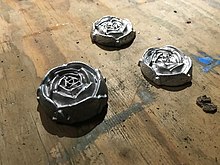| This biography of a living person relies on a single source. You can help by adding reliable sources to this article. Contentious material about living people that is unsourced or poorly sourced must be removed immediately. (November 2024) (Learn how and when to remove this message) |

Rose's metal, Rose metal or Rose's alloy is a fusible alloy with a low melting point.
Rose's metal consists of 50% bismuth, 25–28% lead and 22–25% tin. Its melting point is between 94 and 98 °C (201 and 208 °F). The alloy does not appreciably contract or expand on solidification, this characteristic being a function of its bismuth percentage, but does slightly contract on cooling.
Uses
Rose's metal has several common uses:
- As a solder. It was used to secure cast iron railings and balusters in pockets in stone bases and steps.
- As a heat transfer medium in heating baths.
- As a malleable filling to prevent tubes and pipes from crimping when bent. Rose's metal is melted and poured into the tube. It then solidifies in place but remains malleable. This allows the tube or pipe to be bent and reworked without crimping. After the desired shape is achieved the Rose's metal is remelted and removed, leaving the pipe or tube in its modified shape.
History
It was discovered by the German chemist Valentin Rose the Elder, the grandfather of Heinrich Rose.
Similar metals
| Alloy | Melting point | Eutectic? | Bismuth % |
Lead % |
Tin % |
Indium % |
Cadmium % |
Thallium % |
Gallium % |
Antimony % |
|---|---|---|---|---|---|---|---|---|---|---|
| Rose's metal | 98 °C (208 °F) | no | 50 | 25 | 25 | – | – | – | – | – |
| Cerrosafe | 74 °C (165 °F) | no | 42.5 | 37.7 | 11.3 | – | 8.5 | – | – | – |
| Wood's metal | 70 °C (158 °F) | yes | 50 | 26.7 | 13.3 | – | 10 | – | – | – |
| Field's metal | 62 °C (144 °F) | yes | 32.5 | – | 16.5 | 51 | – | – | – | – |
| Cerrolow 136 | 58 °C (136 °F) | yes | 49 | 18 | 12 | 21 | – | – | – | – |
| Cerrolow 117 | 47.2 °C (117 °F) | yes | 44.7 | 22.6 | 8.3 | 19.1 | 5.3 | – | – | – |
| Bi-Pb-Sn-Cd-In-Tl | 41.5 °C (107 °F) | yes | 40.3 | 22.2 | 10.7 | 17.7 | 8.1 | 1.1 | – | – |
| Gallium | 30.0 °C (86 °F) | Pure metal | - | - | - | - | - | - | 100 | – |
| Galinstan | −19 °C (−2 °F) | no | <1.5 | – | 9.5–10.5 | 21–22 | – | – | 68–69 | <1.5 |
References
- "Low melting-point (fusible) alloys" (PDF). Belmont Metals. Retrieved 5 December 2019.
This alloy-related article is a stub. You can help Misplaced Pages by expanding it. |
This article about a specific mineral or mineraloid is a stub. You can help Misplaced Pages by expanding it. |